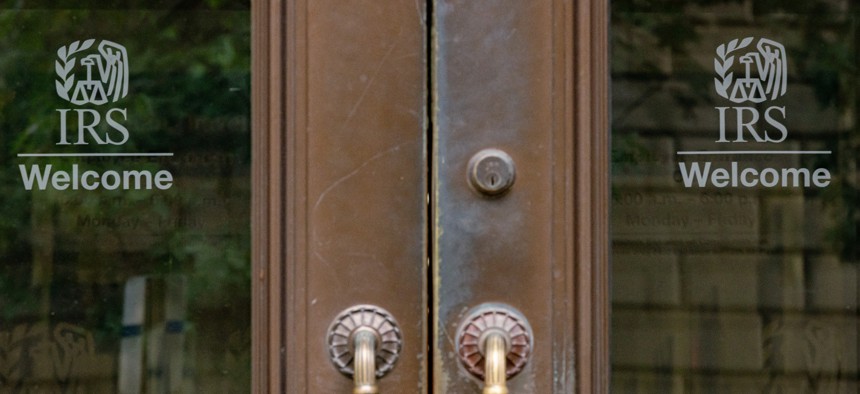
The Trump administration in its fiscal 2026 budget proposal requested a 31% funding increase for the IRS’ Taxpayer Services division. Wesley Lapointe / The Washington Post / Getty Images
Trump wants to reverse the staffing cuts he's overseen for IRS customer service. House Republicans disagree.
The Trump administration is warning of dire consequences if it cannot reverse the tax agency's recent staffing exodus.
While mostly hoping to slash the agency, there is one part of the Internal Revenue Service where President Trump is seeking to significantly add staffing: customer service.
While the White House is hoping to bring on thousands of additional customer service representatives to answer the 100 million phone calls IRS receives every year and attend to taxpayers who frequent in-person assistance facilities, House Republicans have so far rejected that vision.
The caucus has fought for the last several years to dramatically reduce the IRS workforce after President Biden ushered in a hiring spree using a surge of funding provided in the Inflation Reduction Act. The Trump administration has successfully pushed 25,000 employees out of the agency, but now is warning of dire consequences if it does not hire a significant portion of them back.
The Trump administration in its fiscal 2026 budget proposal requested a 31% funding increase for the IRS’ Taxpayer Services division to hire 11,000 employees, a nearly 50% staffing increase. It warned that without such an investment, IRS would see its level of service to taxpayers seeking assistance drop from 85% during the 2025 tax filing season to just 16% in 2026. IRS significantly staffed up its customer service representative force over the last few years using funding from the IRA.
“Funding this investment below the requested level will significantly reduce telephone [level of service] and impair taxpayer services,” IRS said in its budget documents. It added the fallout from a funding shortfall would ultimately “negatively impact taxpayers’ abilities to voluntarily comply with tax laws and will cost the IRS more to function effectively.”
The Fiscal 2026 Financial Services and General Government appropriations bill, which sets funding levels for IRS, would keep funding for Taxpayer Services flat at $2.8 billion, ignoring the $853 million boost Trump requested.
The measure would also slash the IRS enforcement budget nearly in half and $600 million below Trump’s request. It would provide more money than Trump requested for Operations Support, meaning the total funding level in the bill would be only $200 million less than Trump’s proposal for the agency. The total appropriation for IRS would drop by 23% in fiscal 2026 under the House legislation, compared to 20% in Trump’s request.
Doreen Greenwald, president of the National Treasury Employees Union, said the Republican proposal would result in backlogs, slower refunds, more uncollected taxes and fewer tax cheats getting caught.
“Customer Service Representatives are an incredibly vital piece of our tax system because they are on the front lines helping honest taxpayers meet their tax obligations and avoid errors,” Greenwald said. “Slashing this part of the workforce is a disservice to the millions of Americans who contact the IRS every year for help.”
Rep. Steny Hoyer, D-Md., the top Democrat on the House Appropriations Committee’s panel that oversees IRS funding, decried the Republican legislation.
“These cuts will also undermine customer service for Americans trying to contact IRS about questions on their taxes,” Hoyer said.
IRS has so far shed 8,600 employees from Taxpayer Services, or around 20% of the division’s workforce. Those employees, like most others at IRS, were offered various incentives to push them out the door. In some cases, their separations were delayed so as to not interfere with the most recent tax filing season. Now, the Trump administration is looking to more than reverse those changes.
Overall, Trump is still seeking to dramatically slash the IRS workforce. The agency has already shed 25% of its workforce, erasing all the hiring gains President Biden oversaw during his term. More than 20,000 employees left from the deferred resignation program alone, which allowed employees to sit on paid leave for several months before separating from government service.
IRS has yet to implement widespread layoffs—it has so far only targeted a few hundred employees at specific offices—but as of earlier this year, it was preparing to implement significant reductions in force.
Share your news tips with us:
Eric Katz: ekatz@govexec.com, Signal: erickatz.28
NEXT STORY: Census is planning on hiring fewer temporary workers for the 2030 count, watchdog reports







